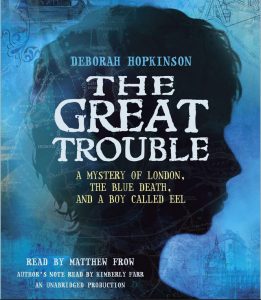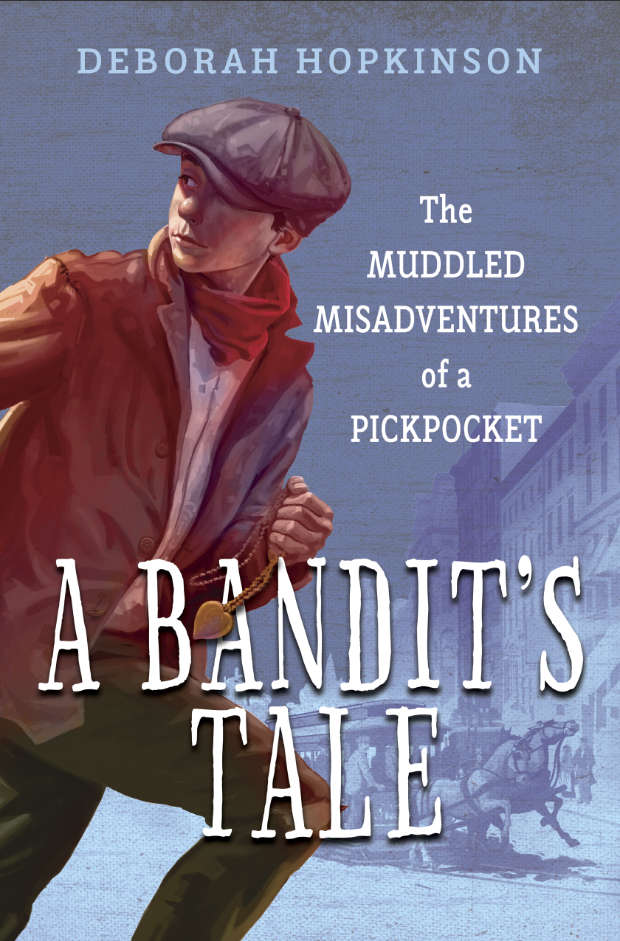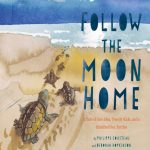 Just as I began this post, the first copies of the paperback edition of The Great Trouble arrived on my doorstep. I love when my books become available in this more affordable format for young readers and their families. And I’m especially pleased about this for The Great Trouble because of the timely nature of its subject matter.
Just as I began this post, the first copies of the paperback edition of The Great Trouble arrived on my doorstep. I love when my books become available in this more affordable format for young readers and their families. And I’m especially pleased about this for The Great Trouble because of the timely nature of its subject matter.
I first learned about Dr. John Snow, the pioneering physician many consider the father of public health, through Steven Johnson’s fascinating adult nonfiction title The Ghost Map. I knew then that I had to find a way tell this story for young readers. But what I didn’t know was the extent to which the 2010 earthquake in Haiti would lead to a devastating cholera epidemic there or how the ravages of the Ebola epidemic would be felt in communities in Africa and beyond in 2014.
Since The Great Trouble was published, I’ve had the honor of introducing Dr. Snow and his work to young people in schools around the country and also abroad, in New Delhi and London. Whenever I speak to students, I begin by reviewing the essential differences between historical fiction and nonfiction. In The Great Trouble, the fictional Eel and his friend Florrie are caught up in a horrible cholera outbreak in their London neighborhood in 1854, at a time when everyone believed that cholera was caused by miasma, or bad air. Eel knows of only one man who might have answers. It’s a race to see if Eel can help Dr. Snow solve the mystery of cholera while eluding the grasp of his evil stepfather, Fisheye Bill Tyler.
While I hope readers are drawn in by the Dickensian aspects of the story, when meeting with students face to face or on Skype I focus on how, like Dr. Snow, we can use evidence to develop a hypothesis and test its validity. Snow’s famous 1855 map of the Broad Street epidemic, reproduced in the book, may be familiar to public health students everywhere, but most young people are seeing it for the first time. Making deductions about the map and trying to imagine living at a time when something that seems obvious to us now – that cholera is caused by water – is one way to develop a sense of historical context. It also helps us appreciate the challenges public health workers face today when dealing with people’s fears and misconceptions about frightening diseases like Ebola.
Students sometimes ask which I prefer writing: fiction or nonfiction. I write in both genres; my next book, Courage & Defiance, Stories of Spies, Saboteurs, and Survivors in World War II Denmark will be out this year and A Bandit’s Tale, The Muddled Misadventures of a Pickpocket, historical fiction middle grade novel set in New York City in the late 1880s, is scheduled for Spring 2016. The truth is, I love research because it gives me the opportunity to learn new things. It’s a passion I hope to pass on to my readers.
– Deborah Hopkinson
Discussion questions for The Great Trouble:
1. Why do you think cholera is also called “the blue death?”
2. What is Dr. Snow’s hypothesis and how does he try to go about trying to prove it?
3. Why do we still have cholera epidemics today, even when we know what causes the disease?
4. Why is Eel’s trip to Mrs. Eley’s house in the country so important?
5. Why do you think people still remember Dr. Snow’s map and the Broad Street pump?
Awards for
The Great Trouble: A Mystery of London, the Blue Death, and a Boy Called Eel
A School Library Journal Best Book of the Year
A CCBC Choice
An NCSS-CBC Notable Social Studies Trade Book for Young People
A Capitol Choices Noteworthy Book for Children and Teens
A Junior Library Guild Selection
Winner of the Oregon Spirit Book Award
Finalist for the Eloise Jarvis McGraw Award for Children’s Literature
Reviews for
The Great Trouble: A Mystery of London, the Blue Death, and a Boy Called Eel
“Set amid the 1854 London cholera outbreak, Hopkinson’s attention-grabbing story of Eel, an orphan who survives by combing the filthy banks of the Thames for anything he might sell, is a delightful combination of race-against-the-clock medical mystery and outwit-the-bad-guys adventure.”
– Starred Review, Publishers Weekly
“Eel struggles to survive as he is falsely accused of stealing by his boss at the brewery, tries to stay clear of his evil stepfather, and watches his neighbors fall ill and die.”
– Starred Review, School Library Journal
“It’s impossible not to like the fictional Eel, who tells the tale in journal form from a first-person point of view, with a convincingly childcentric focus on lovable pets, lemon ice, trust and justice.”
– Kirkus Reviews
Title: The Great Trouble: A Mystery of London, the Blue Death, and a Boy Called Eel
Author: Deborah Hopkinson
ISBN: 9780375843082
Publisher: Yearling
Pub Date: February 10, 2015
 It’s been wonderful to read about the work that Dr. Charlene Klassen Endrizzi and Karen Matis have done with seventh grade students using books including my historical fiction novel, The Great Trouble, as part of an exploration of “Responsible Citizens and Workers.”
It’s been wonderful to read about the work that Dr. Charlene Klassen Endrizzi and Karen Matis have done with seventh grade students using books including my historical fiction novel, The Great Trouble, as part of an exploration of “Responsible Citizens and Workers.”
The Great Trouble takes place in 1854 London, during a moment in time when pioneering epidemiologist John Snow convinced local authorities to act to protect public health by removing the handle on the Broad Street pump. It’s no accident that I chose to include Dickensian themes in the subplot of that book. Likewise, Dickens, that voice of 19th century social reform, looms in the background of my new middle grade novel, A Bandit’s Tale, The Muddled Misadventures of a Pickpocket (Knopf, April 5, 2016).
The theme of responsible citizens comes to the forefront in A Bandit’s Tale, which is set in 1887-1888 New York City and includes as minor characters two of the century’s most prominent social reformers: Jacob Riis and Henry Bergh. The story is told in picaresque style by Rocco Zaccaro, a young Italian immigrant forced to work as a street musician. The light-hearted chapter headings (e.g. “I encounter meddlers and am tormented by a sausage”) are inspired by the novelist Henry Fielding, whom Dickens admired so much he named one of his sons Henry Fielding Dickens.
In the story, Rocco encounters Mary Hallanan, the young Irish daughter of a Greenwich Village blacksmith (yes, there were blacksmiths in the Village). Mary’s favorite book is Anna Sewell’s Black Beauty and through her father, a character also based on a real person, she becomes an active volunteer with the ASPCA, founded by Henry Bergh in 1866. (The ASPCA celebrates its 150th anniversary in 2016.) Mary is a true “meddler,” committed to improving conditions for work horses, including keeping watch for dangerous holes in cobblestoned streets. I think this definitely in character for the real Henry Bergh, who was indefatigable in this regard. In my research at the Museum of the City of New York, I came upon letter after letter he sent to the head of the public works department.
In my story, Mary and her father also count among their friends Jacob Riis, a Danish immigrant who used the invention of flash photography to draw attention to the horrific conditions of living conditions in the tenements. In 1890, Riis wrote How the Other Half Lives and he worked with Theodore Roosevelt on bringing improvements to the Lower East Side. Both he and Bergh were also involved as founders of the New York Society for the Prevention of Cruelty to Children, where I did some of the research for this book.
At author visits in schools, I show students the famous photo of young boys next to a horse carcass, which helped inspire me to write this book. This was a time when people said, “Horses are cheaper than oats.” We’ve included this photo — and others — in the book as well, to help bring this tumultuous period to life for young readers. There is also an extensive author’s note with background information.
There are also great STEM connections here. I encourage educators to watch Steven Johnson’s fantastic PBS series, How We Got to Now, which traces the evolution of ideas and innovation. Dr. John Snow is featured in the episode entitled “Clean,” and Johnson shows how the invention of flash photography made Jacob Riis’s work possible in the episode on “Light.” The series is engaging and entertaining, and just perfect for middle schoolers.
Title: A Bandit’s Tale: The Muddled Misadventures of a pickpocket
Author: Deborah Hopkinson
ISBN: 9780385755023
Publisher: Yearling
Pub Date: April 3, 2018
 Coincidentally, this spring my picture book, Follow the Moon Home (Chronicle Books, April 5, 2016) co-authored with Philippe Cousteau and with lovely illustrations by Meilo So, follows a summer school class that undertakes a community project to protect sea turtles.
Coincidentally, this spring my picture book, Follow the Moon Home (Chronicle Books, April 5, 2016) co-authored with Philippe Cousteau and with lovely illustrations by Meilo So, follows a summer school class that undertakes a community project to protect sea turtles.
I hope that reading about the early years of movements to protect animals and children — and seeing a current model in action — will inspire young readers to think about the roles that activism and philanthropy will play in their own lives.
– Deborah Hopkinson
Title: Follow the Moon Home
Author: Deborah Hopkinson
Illustrator: Philippe Cousteau
ISBN: 978-1452112411
Publisher: Yearling
Pub Date: April 5, 2018
Visit Deborah Hopkinson or follow her on Twitter.
